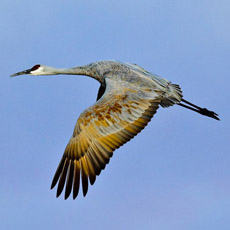Crane-Dance
At dusk along the Platte wave after wave
of sandhill cranes wing their way lower—
drifting, arching, stilt-legs extending—
landing their bones hollow into shallow water.
their great noise must be in celebration,
voice joining voice, tallying who made it
this far, this half-way stopover on the narrow
flyway, enroute to northern mating grounds.
All night in the sandy riverbed clamoring,
overhead stars illuminating a rural sky.
An urge older than imagination. Watching
I can't help thinking biology and love,
how genetics prove efficient on behalf of species.
A scientist might define it—the crane-dance,
the lively display of feathers for a beloved—
as programming. Yet the mystery, the rush:
in your eye a look, a signal, in your body
a call, a scent, all around the loosening,
the melt, the unrestraint of near-spring,
on the horizon a cradle moon, bone-thin.
Crane, Sandhill
Grus canadensis

Notes
If this poem's main tension lies in the conflict of scientific explanations versus the visceral "mystery, the rush" of crane migration, the poem's musicality provides the reader with a "rush" in itself, with the often dactylic drive of many of the lines evincing a feeling of action and drama. One might also point to the alliterative w's of the first stanza, and then the playful internal-near-rhymes of "hollow" and "shallow" and "tallying." The abrupt sentence fragment "An urge older than imagination" is powerful, and anticipates the fuller Romantic critique to follow of analysis of the birds' behavior via "biology" and "genetics"; how much better, the poet implies, to partake oneself in this primordial rite of spring, to feel the "loosening," the "unrestraint" of the dance.
